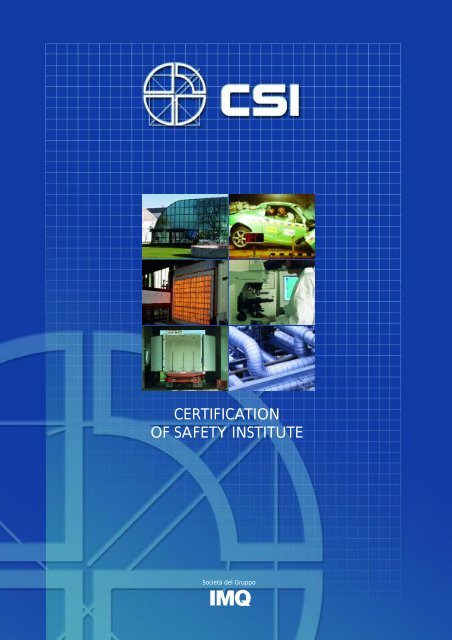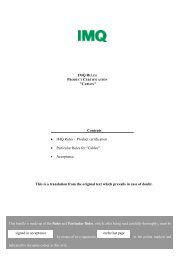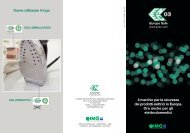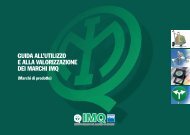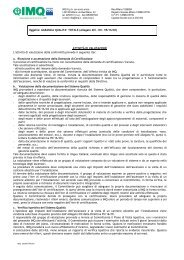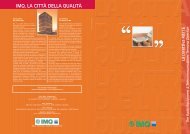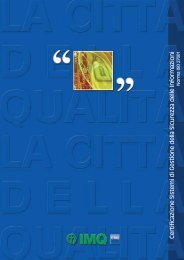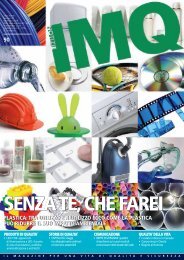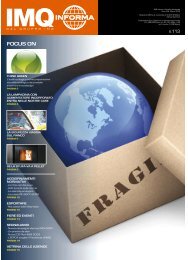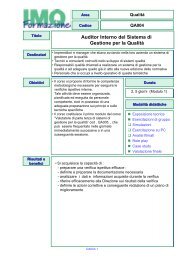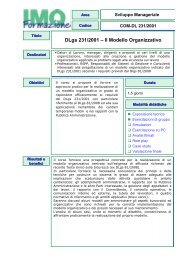CSI Certification of Safety Institute - Imq
CSI Certification of Safety Institute - Imq
CSI Certification of Safety Institute - Imq
- No tags were found...
You also want an ePaper? Increase the reach of your titles
YUMPU automatically turns print PDFs into web optimized ePapers that Google loves.
www.csi-spa.com/divmeccanicaDIVISIONE MECCANICAMECHANICAL DIVISIONbasso, dai lati e dall’alto.Sono disponibili videocamere al alta -velocità, anche a colori, collegate ad uns<strong>of</strong>isticato s<strong>of</strong>tware elettronico di analisiin grado di gestire contemporaneamentei filmati e di eseguire analisi e calcolisu punti e zone definite in vettura.La strumentazione di gestione ed analisiè in grado di fornire all’utente il filmatodella prova, sia in formato digitale,sia in formato VHS.L’acquisizione dei dati ottenuti dallamappatura con sensori della vettura ègarantita sino ad un massimo di 100canali grazie ad un sistema di acquisizione“on board” in grado di operare inaccordo alle vigenti normative ISO inmateria.Lo stesso sistema è in grado di acquisirei segnali derivanti dai sensori montatisui manichini di prova.L’analisi dei segnali ottenuti e la verificadei parametri biomeccanici viene eseguitautilizzando un s<strong>of</strong>tware specificodi analisi.L’impianto è dotato di manichini riproducentibambini dall’età di zero sino a12 anni di manichini conformi al regolamentiECE 16, Hybrid II, Hybrid III eEurosid (side impact dummy).and run by experienced technicians.- Product development and validation- Type Approval in accordance withEEC, FMVSS or other standards- Conformance <strong>of</strong> productionare the activities presently being carriedout by <strong>CSI</strong>.The Mechanical Division Laboratorieshave been acknowledged by FIA (InternationalAutomobile Federation) for thetype-approval tests <strong>of</strong> Formula 1 cars,other racing categories cars, sport carcomponents (seats, safety belts) andsafety garments (racing driver suits).The crash Laboratory for automobilesemploys the most recent and advancedpropulsion and control technologies thatmanage and guarantee impact velocitiesin the range <strong>of</strong> 4 to 80 km/h with theprecision within 0,1 km/h, for the vehicleshaving a weight up to 3500 kg. Thecontrol system is designed to run theacceleration ramp between 0,1 and 0,5g. The crash tests are filmed with FastMotion Video system that permits thedigital filming up to 1000 photograms/sec<strong>of</strong> all crash tests. The positioning<strong>of</strong> the videocameras permits the filmingfrom either side, top view or fromunderneath <strong>of</strong> the tested automobile.Such films then, can be further elaboratedby computer to obtain additionalengineering dynamic behavioural dataand converted to VHS cassette system.The Crash Laboratory has been equippedwith data acquisition and elaborationsystem that permits to verify thetested vehicle impact velocity anddecelerations at different points <strong>of</strong> theautomobile.In particular; in order to obtain the datarelative to strenght resistance <strong>of</strong> theautomobile during the dynamic event,it is possible to install an on boardacquisition system. The system is capableto run up to 100 channels <strong>of</strong> accelerationacquisition, thanks tomonoaxial and triaxial sensors (accelerometers).The system has been built inconformity to relative ISO standard.The same system is employed for thetest data acquisition <strong>of</strong> the bio-mechanicaldummies. The analysis <strong>of</strong> the biomechanicalparameters is performedwith a specific analysis s<strong>of</strong>tware.The laboratory is equipped with testdummies that reproduce the childrenwhose the age ranges from zero up to12 years with dummies Hybrid II, HybridIII and Eurosid (Side Impact Dummy)and with dummies in conformity to ECE16 regulations.6 7
www.csi-spa.com/divmeccanicaDIVISIONE MECCANICAMECHANICAL DIVISIONSETTORE SICUREZZAE AFFIDABILITA'LA Divisione Meccanica di <strong>CSI</strong> SpA è ingrado di verificare la rispondenza airequisiti di sicurezza imposti da normetecniche di riferimento nonchè dalledirettive comunitarie riguardanti la resistenzae l'affidabilità di prodotti sottopostia fenomeni di carico statico, dinamico,d'urto e sollecitazioni di tipo termico.E' quindi, possibile analizzare il comportamentodi strutture o componenti sottocarico o verificare la presenza di frequenzecritiche durante transitori <strong>of</strong>enomeni vibratori. E' possibile analizzarela resistenza di componenti soggettia gradienti termici sia in termini di resistenzameccanica sia in termini di dilatazioneo deformazione, di verificarevari tipi di imballo soprattutto quellidestinati al trasporto di merci pericolose,di verificare la rispondenza deidispositivi di protezione individuale.Prove eseguibili:- Simulazione percorsi stradali- Rilievo sollecitazioni su strada- Prove su recipienti in pressione inaccordo alla norma EN 3- Prove su cassonetti rifiuti in accordoalle norme EN 840, UNI 10571- Prove su materassi in accordo allenorme UNI 10707, EN1957, EN1725,EN 1334- Prove su imballaggi completi epieni secondo le norme ISO 2233,ISO 2234, ISO 2244, ISO 2247,ISO2248, EN22872, EN22874,EN22876<strong>CSI</strong> SpA è notificato dalla comunitàEuropea per la marcatura CE deidispositivi di protezione del capo. E' ingrado di eseguire tutte le prove di certificazionee di sviluppo secondo le principalinorme Europee e Statunitensi.AFFIDABILITÀProve di fatica, durata, impatto ecarico su biciclette e componentiquali forcelle, telai, pieghe manubrio,selle, attacco sella, ruote,pedali e pedivelle, movimento centralein accordo alle norme UNI 10395,UNI 10518, NF R30-020, DIN 79100/2,ISO 8040.SAFETY AND RELIABILITYSECTORThe Mechanical Division <strong>of</strong> <strong>CSI</strong> S.p.A. iscapable to verify the conformance tosafety requirements <strong>of</strong> the referencetechnical standards and the EEC directivesrelative to the products resistanceand reliability when subjected to thestatic loads, dynamic loads, impacts andtemperature stresses. Hence, it is possibleto evaluate the behaviour <strong>of</strong> thestructures or components under load,and verify the critical frequencies intransit conditions or vibrations phenomenon.It is also possible to evaluate the resistance<strong>of</strong> the components when subjectedto thermal gradients in terms <strong>of</strong>both, the mechanical resistance as wellas deformation or expansion effects, toverify the different types <strong>of</strong> packagingand most <strong>of</strong> all those employed for thetransportation <strong>of</strong> dangerous goods,and to verify the conformance <strong>of</strong> thepersonal protection devices.<strong>CSI</strong> S.p.A. has been notified by theEEC for CE marking <strong>of</strong> the head protectiondevices. It is equipped and capableto carry out all the development andcertification tests in accordance withthe principal EEC and USA standards.RELIABILITYFatigue tests, endurance, impactand static loading <strong>of</strong> the bicyclesand its components like forks, frames,handle bars, seats and its sup-8 9
www.csi-spa.com/divmeccanicaDIVISIONE MECCANICAMECHANICAL DIVISION- Prove su lettini bambini secondola norma EN716- Prove climatiche e termiche inaccordo alle norme IEC68, CapitolatiClienti- Prove vibrazioni secondo Mil STD810E - IEC68- Prove sinusoidali- Prove random- Prove sine on random- Prove random on random- Prove di shock (half sine, square,toothsaw)- Prove di bump- Prove di cadutaOMOLOGAZIONIPER TRASPORTOMERCI PERICOLOSEsecondo accordo ONU ADR/ RID, IMGCCode, DM del 23.05.85, direttive94/55/CE e 96/49/CEProve eseguibili:- Drop test- Stacking test- Topple test- Hydraulic test- Leakpro<strong>of</strong>ness test- Permeability test- Tests <strong>of</strong> pressure tanks in accordancewith EN 3 standard- Tests <strong>of</strong> the street garbage containersin accordance with EN 840,UNI 10571 standards- Test <strong>of</strong> the mattresses in accordancewith UNI 10707, EN 1957, EN1725, EN 1334 standards- Tests <strong>of</strong> complete packagingsystems in accordance with ISO 2233,ISO 2234, ISO 2244, ISO 2247, ISO2248, EN 22872, EN 22874, EN 22876standards- Test <strong>of</strong> the children cots in accordancewith EN 716- Tests in the climatic chamber inaccordance with IEC 68 and client’sspecifications- Vibration tests in accordance withMIL STD 810E and IEC 68 standards- sine tests- random tests- sine on random tests- random on random tests- shock tests (half sine, square, toothsaw)- bump tests- drop testsCERTIFICATION FORDANGEROUS GOODSTRANSPORTATION- Hydraulic tests- Leakpro<strong>of</strong>ness tests- Permeability testsPERSONALPROTECTION DEVICES- Motorcycle helmets certificationin accordance with UN ECE R22.05regulation- CE marking <strong>of</strong> the ski helmets,mountain climbing helmets, bicyclehelmets, fire fighters helmets,horse riding helmets, hockey helmets,helmets for children andwork (industrial) helmets in accordancewith EN 397, EN 812, EN 966,EN 967, EN 1077, EN 1078, EN1080, EN 1384, EN 1385, EN 12492- Tests performed <strong>of</strong> the ski helmets,bicycle helmets, horseriding helmets in accordance withASTM F1163, ASTM F1446, ASTMF1447, ASTM F1492, ASTM F1751,ASTM F1849, ASTM F2040, CPSC 16CFR Part 1203 standards.PROTEZIONE PERSONALE- Omologazioni caschi per motociclistiin accordo a Regolamento ECEONU R22/05- Marcatura CE di caschi per scialpino, per alpinismo, per ciclisti,per vigili del fuoco,per parapendio,per attività equestri, perbambini, per hockey, per l’industriain accordo alle norme EN 397 -EN812 - EN966 - EN967 - EN1077 -EN1078 - EN1080 - EN1384 -EN1385 - EN12492- Prove su di caschi per sci alpino,per ciclisti, per attività equestriin accordo alle norme ASTM F1163- ASTM F1446 - ASTM F1447 -ASTM F1492 - ASTM F1751 - ASTMF1849 - ASTM F2040 - CPSC 16 CFRPart 1203port structures, pedals and the centralmovement systems are tested inaccordance with UNI 10395, UNI10518, NF R30-020, DIN 79100/2, ISO8040 standards.Tests that are carried out:- Road simulation- Data acquisition <strong>of</strong> the road pr<strong>of</strong>ilestressIt is carried out in accordance with UNADR7RID, IMGC code, DM dated23/05/85, EEC directives 94/55/EC and96/49/EC.Tests performed:- Drop tests- Stacking tests- Topple tests10 11
www.csi-spa.com/divcostruzDIVISIONECOSTRUZIONILa Divisione costruzioni affronta problemilegati prevalentemente al settoreedile, ove le tematiche relative alla sicurezza,al comfort, al risparmio energeticodiventano rilevanti.La sicurezza verso il pericolo d'incendiocoinvolge sia la natura dei materiali, siala tipologia e la natura delle strutture,sia l'efficienza dei sistemi e mezzi d'estinzione.Il comfort degli ambienti investe sia gliaspetti microclimatici (temperatura,umidità, salubrità) sia gli aspetti acustici.Il risparmio energetico è legato all'uso dimateriali idonei ed all'adozione di soluzionicostruttive e di sottosistemi ediliefficaci verso i fenomeni termici.La Divisione Costruzioni affronta questiproblemi sia in termini teorici, sia in terminisperimentali potendo contare suuna equipe di Ingegneri e Tecnici altamentespecializzati e di strumenti edattrezzature evoluti. Le aree di maggiorcoinvolgimento della Divisione Costruzionisono il Comportamento al Fuococon la reazione, la resistenza e la protezioneattiva contro gli incendi.COMPORTAMENTOAL FUOCO<strong>CSI</strong> è autorizzato dal Ministero dell’Internoper certificazioni di reazionee resistenza al fuoco ai fini dellaomologazione di stato.l laboratori di comportamento al Fuocodi <strong>CSI</strong> svolgono attività di ricerca in collaborazionecon Enti Pubblici quali ilCentro Studi ed Esperienze dei Vigili delFuoco di Roma-Capannelle (C.S.E.), conil CNR ed enti normativi quali UNI, ISO,CEI, rivolte soprattutto alla definizione eallo sviluppo di criteri di valutazione e dimetodologie di prova.I Laboratori di reazione e resistenzaal fuoco di <strong>CSI</strong> fanno parte di EGOLF(European Group <strong>of</strong> Official Laboratoriesfor Fire) , organizzazione internazionaleche supporta, sotto il pr<strong>of</strong>ilo tecnico,proposte di normative armonizzatea livello europeo. Tecnici di <strong>CSI</strong> su delegadell’UNI rappresentano l’Italia inComitati Tecnici del CEN (ComitatoEuropeo di Normazione).<strong>CSI</strong> è accreditato SINAL per le prove diresistenza e di reazione al fuoco nell’ambitoeuropeo, inoltre, <strong>CSI</strong> ha presoaccordi di mutuo riconoscimento conimportanti laboratori internazionalioperanti nella stessa area.CONSTRUCTIONDIVISIONThe construction division deals withproblems mainly connected with thebuilding sector, where themes suchsafety, comfort and energy saving become<strong>of</strong> paramount importance.<strong>Safety</strong> against fires involves several factorssuch as nature <strong>of</strong> the materials,type and nature <strong>of</strong> the structures andefficiency <strong>of</strong> the extinguishing systemsand devices. The room comfort dealswith both the microclimatic (temperature,moisture, salubrity) and the acousticaspects.Energy saving is connected with the use<strong>of</strong> suitable materials and the adoption<strong>of</strong> constructive solutions and <strong>of</strong> effectivebuilding subsystems against thermalphenomena.The construction division faces the abovementioned problems both theoreticallyand experimentally thanks to ateam <strong>of</strong> highly specialized engineersand technicians and to advanced equipmentsand instrumentations. The sectorswhere the division is mainly involvedare behaviour in fire, i.e. firereaction, fire resistance and active protectionagainst fires.BEHAVIOUR IN FIRE<strong>CSI</strong> is authorized by the Ministry <strong>of</strong>the Interior for the certifications <strong>of</strong>fire reaction and fire resistance forthe aim <strong>of</strong> the state homologation.<strong>CSI</strong> fire laboratories perform researchactivity in cooperation with publicbodies such as Centro Studi ed Esperienzedei Vigili del Fuoco di RomaCapannelle (C.S.E.) (Fire-men Researchand Investigation Centre, sited nearRome), CNR (National Scientific ResearchCouncil) and normative bodies e.g.UNI, ISO, CEI, principally concerned withthe definition and the development <strong>of</strong>evaluation criteria and testing methods.Fire reaction and resistance laboratoriesare part <strong>of</strong> EGOLF (EuropeanGroup <strong>of</strong> Official Laboratories for Fire),an international organization that supports,under a technical pr<strong>of</strong>ile, harmonizednormative proposals at europeanlevel. <strong>CSI</strong> technicians, delegated byUNI, represent Italy in CEN (EuropeanStandardization Committee) technicalcommittees. <strong>CSI</strong> is accredited by SINALfor the fire reaction and fire resistance1213
www.csi-spa.com/divcostruzDIVISIONE COSTRUZIONICONSTRUCTION DIVISIONReazione al fuocoNormative di prova- D.M. 26.06.84; ISO/DIS 1182.2; CSERF 1/75/A; CSE RF 2/75/A; CSE RF3/77; CSE RF 4- UNI 8456; UNI 8457; UNI 9174; UNI9175; UNI 9796- DIN 4102 teil 2- NF P 92-501; NF P 92-505- BS 476 Part 7- BS 5852 Part 1; Part 2- BS 7176- BS 7177- Technical Bullettin 117- Commercial Standard 191-53- UNI - EN 1021 Parte 1- UNI - EN 1021 Parte 2- EN - ISO 12952-1- EN - ISO 12952-2- ISO 8191 Part 1- ISO 8191 Part 2- ISO 1182- Specifica FS N° 306572- Specifica FS N° 306574- Resolution A.688(17)- Resolution A.652(16)- UNI ISO 3795- FMVSS 302- UTAC 18-502/1- UTAC 18-502/2- Dir. 95/28/CE - Allegato IV- Dir. 95/28/CE - Allegato V- Dir. 95/28/CE - Allegato VI- FIA 1986 - ISO 6940- FIA 1986 - ISO DP 9151- CEI 20-22 - 3- CEI 20-37 - 4Prodotti- Rivestimenti tessili per pavimenti(moquettes)- Rivestimenti non tessili per pavimenti(linoleum, legno, gomma etc..)- Pavimentazioni sopraelevate- Contros<strong>of</strong>fitti sospesi ed a membrana- Rivestimenti di parete- Lastre alveolari per pareti leggere- Pareti divisorie- Lucernari- Lastre e tubi isolanti per pareti e condottedi ventilazione e riscaldamento- Teloni per strutture presso statiche- Tendoni- Vernici ignifughe per legno- Mobili imbottiti (poltrone, divani)- Materassi- Sommier- Guanciali- Mobili imbottiti (poltrone, divani)- Componenti per mobili imbottiti (tessuto,imbottitura)- Materiali impiegati per imbottiture persedili, divani, cuccette e letti di veicoli FS- Materiali impiegati negli abitacolidegli autoveicoli e conduttori elettrici- Materiali utilizzati per l'allestimentodi autobus urbani e da turismo- Tessuti impiegati per tute per piloti dicompetizioni automobilistiche- Tute per piloti di competizioni automobilistiche- CaviResistenza al fuocoNormative di prova- Circolare 91- D.M. 14.12.94- UNI 9723- UNI 7678- ISO CD 834- BS 476 p.20- DIN 4102 p.2- ASTM E119- EN 1363 p.1- EN 1363-2 (curve Hydrocarbon, Slowtests within Europe. <strong>CSI</strong> has enteredmutual recognition agreements withimportant international laboratoriesworking in the same field.Fire reactionTest norms- D.M. 26.06.84; ISO/DIS 1182.2; CSERF 1/75/A; CSE RF 2/75/A; CSE RF3/77; CSE RF 4- UNI 8456; UNI 8457; UNI 9174; UNI9175; UNI 9796- DIN 4102 teil 2- NF P 92-501; NF P 92-505- BS 476 Part 7- BS 5852 Part 1; Part 2- BS 7176- BS 7177- Technical Bullettin 117- Commercial Standard 191-53- UNI-EN 1021 Parte 1- UNI-EN 1021 Parte 2- EN-ISO 12952-1- EN-ISO 12952-2- ISO 8191 Part 1- ISO 8191 Part 2- ISO 1182- Specifica FS n. 306572- Specifica FS n. 306574- Resolution A. 688 (17)- Resolution A. 652 (16)- UNI ISO 3795- FMVSS 302- UTAC 18-502/1- UTAC 18-502/2- Dir. 95/28/CE – Allegato IV- Dir. 95/28/CE – Allegato V- Dir. 95/28/CE – Allegato VI- FIA 1986 – ISO 6940- FIA 1986 – ISO DP 9151- CEI 20-22 –3- CEI 20-37 –4Products- Textile coverings for floors (moquettes)- Non-textile coverings for floors (linoleum,wood, rubber)- Raised floorings- Membrane and suspended false ceilings- Wall coverings- Honey-combed plates for light walls- Partition walls- Skylights- Insulation plates and pipes for wallsand heating and ventilation conduits- Canvas for pressure static structures- Draperies- Firepro<strong>of</strong> paints for wood- Upholstered furniture (armchairs ands<strong>of</strong>as)- Mattresses- S<strong>of</strong>a-beds- Pillows- Components for upholstered furniture(textiles, paddings)- Materials for the padding <strong>of</strong> seats,s<strong>of</strong>as, couchettes and beds <strong>of</strong> italianstate railway carriages- Materials and electrical cables used inthe driver and passengers compartment<strong>of</strong> automotives- Materials for the fitting out <strong>of</strong> cityand touring buses- Textiles for the manufacturing <strong>of</strong>racing car driver suits- Suits for racing car drivers- CablesFire resistanceTest norms- Circolare 91- D.M. 14.-12.94- UNI 972314 15
www.csi-spa.com/divcostruzDIVISIONE COSTRUZIONICONSTRUCTION DIVISIONheating, External Fire exposure)- Curva Hydrocarbon Maggiorata(HCM)- FICHE 564-2- ISO 834Prodotti- Pareti prefabbricate- Muri in blocchi- Porte tagliafuoco- Infissi tagliafuoco- Solai in legno, c.a. acciaio- Travi in legno c.a, c.a.p., ed acciaioprotette e non- Intonaci di protezione al fuoco- Vernici intumescenti e sublimanti perprotezione al fuoco di strutture- Lastre di protezione scatolare strutture- Coppelle per tiranti- Serrande tagliafuoco- Barriere antifiamma- Testate ferroviarie- Pianali ferroviari- Pareti di compartimentazioneProtezione attiva controgli incendiNormative di prova- D.M. 20.12.82- D.M. 06.03.92- UNI 9492- UNI EN 3 Parte 1, 2, 3, 4, 5, 6Prodotti- Estintori portatili di incendio- Estintori carrellati di incendioFIRE ENGINEERINGL’approccio ingegneristico alle problematichedi resistenza al fuoco di strutturerilevanti per concezioni architettonicheinnovative e per utilizzo di materialinuovi o combinati, diventa indispensabileallorchè la risposta deve dare un giudiziodiscriminante all’impiego. Grazie aquesto approccio <strong>CSI</strong> è stato chiamato adare il suo contributo determinante allaverifica comportamentale delle strutturedi grandi opere, quali le arcate dellaBasilica di Padre Pio e dell’Auditoriumdel Comune di Roma, entrambi progettatidall’Arch. Renzo Piano, nonché allasoluzione degli interventi risolutori per lasicurezza del Monte Bianco, e del SanGottardo, per cui <strong>CSI</strong> è stato il laboratorioeuropeo di riferimento.La cultura di <strong>CSI</strong> acquista nel campo delFire Engineering consente anche pienaattuazione di quanto previsto dal DM. 8Maggio 1998, e la realizzazione di abachiper sistemi di protezione per elementistrutturali.FISICA TECNICA<strong>CSI</strong> ha una cultura consolidata e di granderilevanza nel campo dei fenomeniacustici: il Laboratorio di Acustica vantaun equipe di tecnici di alta pr<strong>of</strong>essionalità,tre camere acustiche riverberantistrutturate in modo da eseguire numerosetipologie di misura, strumenti evoluti es<strong>of</strong>isticati che consentono grande affidabilitàe tempi di esecuzione ristretti.Il Laboratorio di Rubinetteria è particolarmenteattrezzato per eseguire le provepreviste dalle normative europee nelcampo della Rubinetteria Sanitaria (provedi portata e sensibilità, di pressione,di tenuta, di fatica, ecc.) ed inoltre provea fatica di serbatoi, valvole.Nel settore della Rubinetteria Sanitaria,<strong>CSI</strong> gestisce il marchio UNI che, grazie almutuo riconoscimento con buona partedei paesi europei (Germania, Olanda,Spagna, Finlandia, Danimarca, Belgio,Lussemburgo) è accettato in Europa allapari degli altri marchi (DIN,KIWA, NF).I Rubinetti Sanitari fanno parte dellaDirettiva prodotti da Costruzione89/106 CEE.Il Laboratorio di Termotecnica e Sicurezzaè attrezzato per l'esecuzione delleprove di:- Conduttività termica (l) su lastra pianaed a geometria cilindrica- Conducibilità termica (K) di elementidi chiusura (serramenti, pareti)- UNI 7678- ISO CD 834- BS 476 p.20- DIN 4102 p.2- ASTM E119- EN 1363 p. 1- EN 1363-2 (curve Hydrocarbon, Slowheating, External Fire exposure)- Curva Hydrocarbon Maggiorata (HCM)- FICHE 564-2- ISO 834Products- Prefabricated walls- Masonry blocks- Firepro<strong>of</strong> doors- Firepro<strong>of</strong> fixtures- Wooden, concrete and steel floorings- Wooden, concrete, prestressed concreteand steel girders; with orwithout protective covering- Fire pro<strong>of</strong> plasters- Intumescent and sublimating paintsfor the firepro<strong>of</strong>ing <strong>of</strong> structures- Plates for the box-shaped protection<strong>of</strong> structures- Tie-rod covering- Firepro<strong>of</strong> shutters- Firepro<strong>of</strong> barriers- Railway locomotive headstocks- Railway carriage floorings- Partition wallsActive protectionagainst firesTest norms- D.M. 20.12.82- D.M. 06.03.92- UNI 9492- UNI EN 3 Parte 1,2,3,4,5,6Products- Portable fire extinguishers- Truck-mounted fire extinguishersFIRE ENGINEERINGIt becomes indispensable to have theengineering approach to the resistanceto fire aspects <strong>of</strong> the complex structuraldesign solutions, considering also thetype <strong>of</strong> materials being amployed, inorder to obtain the right and uniqueanswer for the specific applications.Thanks to this approach, <strong>CSI</strong> has beenselected to supply the support servicefor verification <strong>of</strong> the structural behaviour<strong>of</strong> the important complex structureslike the arches <strong>of</strong> the Basilique <strong>of</strong>Padre Pio and the Concert Hall in Roma(Auditorium Comunale), both designedby Mr. Renzo Piano. <strong>CSI</strong> ha also beencalled to conduct the effort <strong>of</strong> research<strong>of</strong> the final safety design solutions <strong>of</strong>the Monte Bianco tunnel and the SanGottardo tunnel, becoming a Europeanrefernce laboratory.The know-how acquired by <strong>CSI</strong> in thefield <strong>of</strong> Fire Engineering permits also tocarry out all the activities in full compliancewith the Ministry <strong>of</strong> InteriorDecree dated May 8, 1998 and generation<strong>of</strong> the assesment for the protectionsystems <strong>of</strong> the structural elements.TECHNICAL PHYSICS<strong>CSI</strong> possesses a well established and outstandingculture in the field <strong>of</strong> acousticphenomena. In its Acoustics laboratoryoperate highly skilled technicians andthree reverberating acoustic chambersare structured in order to carry out withgreat reliability and in short times a lot <strong>of</strong>measurements by means <strong>of</strong> advancedand sophisticated equipments.The Taps and Fittings laboratory is particularlysupplied with tools to performthe tests provided for by the europeannorms in the sector <strong>of</strong> sanitary taps(flow, sensitivity, pressure, seal, fatigue,etc, tests) and moreover the fatiguetests <strong>of</strong> tanks and valves. In this sector<strong>CSI</strong> controls the UNI mark which,thanks to the mutual recognition with alarge number <strong>of</strong> european Countries,(Germany, Netherlands, Spain, Finland,Denmark, Belgium, Luxembourg) isaccepted in Europe equally as the othermarks (DIN, KIWA, NF). Sanitary tapsand fittings are part <strong>of</strong> the 89/106 EEC16 17
www.csi-spa.com/divcostruzDIVISIONE COSTRUZIONICONSTRUCTION DIVISION- Tenuta all'aria ed all'acqua di serramenti- Antieffrazione di porte blindatesecondo le normative europee vigentiI prodotti e le normative applicabili per idifferenti settori sono:AcusticaNormative di prova- UNI EN ISO 140 - 3- UNI EN ISO 140 - 6- UNI EN ISO 140 - 8- UNI EN 20354- UNI EN 1793- UNI EN ISO 3822Prodotti- Pannelli- Pareti- Porte- Serramenti- Vetrate- Materiali da costruzione- Rivestimenti per pavimentazione- Materiali per rivestimento di pareti- Materiali per contros<strong>of</strong>fitti- Materiali fonoassorbenti in genere- Dispositivi per la riduzione del rumoreda traffico stradale- Rubinetti ed apparecchiature idrauliche- Tappeti, moquette- Tendaggi e drappeggi- Sedie per abitazioni, uffici, sale cinematografichee teatri- Barriere per la riduzione del rumoreRubinetteriaNormative di prova- UNI EN 200- UNI EN 817- NBK 4- UNI EN 1112- UNI EN 1113- UNI EN 248- UNI ISO 9227Prodotti- Rubinetteria sanitaria- Regolatori di getto- Dispositivi uscita doccia- Flessibili doccia- Prodotti cromatiTermotecnicaNormative di prova- UNI 7745- ASTM C 236- ISO 8497- UNI EN 12207- UNI EN 12208- UNI EN 12210Prodotti- Materiali di coibentazione in lastrapiana e geometria cilindrica- Manufatti in laterizio- Porte e serramenti- Pannelli- ParetiSicurezzaNormative di prova- UNI ENV 1627- UNI ENV 1628- UNI ENV 1629- UNI ENV 1630Prodotti- Porte blindateConstruction Products Directive.The Thermotechnics and <strong>Safety</strong> laboratoryis equipped to perform the followingtests:- Heat conductivity (l) on flat platesand <strong>of</strong> cylindric geometry- Heat transmittance (k) on shuttingelements (windows, walls)- Air and water tightness <strong>of</strong> windows- Forcingpro<strong>of</strong> <strong>of</strong> armour-plated doorsin accordance with the current europeannormsThe norms and the products for the differentsectors are as follows:AcousticsTest norms- UNI EN ISO 140-3- UNI EN ISO 140-6- UNI EN ISO 140-8- UNI EN 20354- UNI EN 1793- UNI EN ISO 3822Products- Panels- Walls- Doors- Windows- Glass walls- Building materials- Floor coverings- Wall covering materials- False ceilings materials- Sound pro<strong>of</strong>ing materials- Devices for the reducing <strong>of</strong> trafficnoise- Taps and hydraulic devices- Carpets, moquettes- Draperies- Chairs for houses, <strong>of</strong>fices, cinemasand theatres- Noise absorption barriersTaps and FittingsTest norms- UNI EN 200- UNI EN 817- NBK 4- UNI EN 1112- UNI EN 1113- UNI EN 248- UNI ISO 9227Products- Sanitary taps- Jet regulators- Shower output devices- Flexible shower pipes- Chrome-plated productsThermotechnicsTest norms- UNI 7745- ASTM C 236- ISO 8497- UNI EN 12207- UNI EN 12208- UNI EN 12210Products- Insulating materials on flat plates and<strong>of</strong> cylindric geometry- Brick manufactured articles- Doors and windows- Panels- Walls<strong>Safety</strong>Test norms- UNI ENV 1627- UNI ENV 1628- UNI ENV 1629- UNI ENV 1630Products- Armour – plated doors1819
www.csi-spa.com/divchimicoDIVISIONE CHIMICA, FISICAE MICROBIOLOGIAI laboratori della Divisione Chimica Fisicae Microbiologia <strong>of</strong>frono alle Aziendeservizi di Testing, di ricerca applicata,validazioni, studi di conformità. I principalisettori di attività sono:- industria dell’imballaggio (alimenti,cosmetici, farmaceutici, dispositivimedici, merci pericolose)- industria alimentare- industria delle materie plastiche edella gomma- edilizia- igiene ambientale- inquinamento industriale- consulenze peritaliLa Divisione Chimica Fisica e Microbiologiacollabora con Istituti pubblici e privati,e sviluppa metodologie di prova nell’ambitodegli enti di normazione .Inoltre assiste le Aziende nella messa apunto di metodiche analitiche, e verificaperiodicamente l’affidabilità delle procedureinterne di controllo di produzionee di prodotto, e ne certifica laconformità a norme tecniche e disposizionidi legge.Le aree di attività riguardano i seguenticomparti:- Testing e Certificazione- Ricerca- Assistenza alle AziendeTESTINGE CERTIFICAZIONII laboratori sono dotati di strumentazioniall’avanguardia nei settori dell’analisichimica (ICP, GC-MS, microscopia FTIR,Purge&Trap, pirolizzatore, HPLC, cinetichedi combustione via FTIR), dellecaratteristiche e proprietà fisiche (caratteristichediffusionali, calorimetriche,termogravimetriche, viscosimetriche,molecolari via GPC, spettroscopiche,stratigrafiche), del controllo dell’igieneambientale (sistemi di campionamentoper l’inquinamento ambientale chimicoe microbiologico di aria, acque e superfici).L’esperienza e le specializzazioni dei tecnicidella Divisione, sostenute dallapotenzialità analitica disponibile, consentonodi operare con tempestività ecompetenza nei seguenti comparti:- IMBALLAGGI per ALIMENTI, FARMA-CI, COSMETICI, PRODOTTI CHIMICIDIVERSI- ALIMENTI, COSMETICI E PRODOTTIPER LA PERSONA- IGIENE AMBIENTALE- IGIENE E IDONEITA’ di: distributoriPHYSICAL CHEMISTRYAND MICROBIOLOGYDIVISIONThe laboratories <strong>of</strong> the Physical Chemistryand Microbiology Division <strong>of</strong>fer theCompanies services <strong>of</strong> testing, appliedresearch, validations, compliance studies.The main activity sectors are:- packaging industry (foodstuffs,cosmetics, pharmaceuticals, medicaldevices, hazardous goods)- foodstuff industry- plastics and rubber industry- building industry- environmental hygiene- industrial pollution- advice <strong>of</strong> expertsThe Physical Chemistry and MicrobiologyDivision cooperates with public andprivate institutes and developes testingmethods within standardization bodies.Moreover it helps the Companies to setup analytical methods, verifies periodicallythe reliability <strong>of</strong> the internal proceduresfor the production and productcontrol and certifies their compliancewith technical norms and legal provisions.The activity areas deal with the followingsectors:- Testing and certification- Research- Advisory servicesTESTINGAND CERTIFICATIONThe laboratories are equipped with themost advanced instrumentation to operatein the following sectors: chemicalanalysis (ICP, GC, MS, FTIR, microscopy,purge and trap, pyrolysis, HPLC, combustion,kinetics via FTIR); characterizationand physical properties (diffusional,calorimetric, thermogravimetric, viscosimetric,molecular via GPC, spectroscopicand stratigraphic); environmentalhygiene control (sampling systems) forthe chemical and microbiologic pollution<strong>of</strong> air, waters and soils.The expertise and the skills <strong>of</strong> the Division,together with the above mentionedanalytical hardware, permit to workpromptly and with competence in thefollowing fields:- Packaging for foodstuffs, pharmaceuticals,cosmetics, various chemicals- Foodstuffs, cosmetics, personal careproducts- Environmental hygiene- Hygiene and suitability <strong>of</strong> food anddrinks automatic dispensers, <strong>of</strong>machines, instruments and accessoriesfor the working and processing <strong>of</strong>foods and <strong>of</strong> apparatuses for food20 21
www.csi-spa.com/divchimicoDIVISIONE CHIMICA FISICAE MICROBIOLOGIAPHYSICAL CHEMISTRYAND MICROBIOLOGY DIVISIONautomatici di alimenti e bevande, macchine,strumenti e accessori per la lavorazionee trasformazione dei cibi, apparecchiper la conservazione dei cibi- EDILIZIA ISOLANTI, IMPERMEABILIZ-ZANTI, RIVESTIMENTI, MALTE, INTO-NACI, VERNICI, SIGILLANTI, STUCCHI- studio dei meccanismi di migrazionespecifica di composti presenti negliimballaggi per alimenti e prodotti farmaceuticia supporto dei requisitiimposti dalle legislazioni italiana edeuropea che disciplinano e regolamentanol’impiego dei materiali eoggetti in materia plastica- quantificazione dei metalli pesanti(Cromo, Piombo, Cadmio e Mercurio)negli imballaggi e nei rifiuti daimballaggio, al fine di rispettare irequisiti della Direttiva 94/62/CE.ASSISTENZAALLE AZIENDELa Divisione di Chimica Fisica e Microbiologiaè da anni partner di numeroseAziende in attività finalizzate a:- ricerca delle cause di anomalie comportamentali(problem solving)- definizione, progettazione, qualificazionee controllo di imballaggi innovativiper prodotti alimentari, farmaceutici,dispositivi medici, cosmetici afronte di specifici obiettivi di efficienza,produttività ed economicità- stesura e applicazione di capitolatiper il controllo di qualità degli imballaggi- valutazione rapide delle prestazionidi un imballaggio sulla base di test diinvecchiamento accelerato- valutazione dell’igiene di siti industrialie commerciali - HACCP- assistenza alle aziende nelle situazionidi contenzioso tecnico e legale (CTP).IL CENTRODI ECCELLENZASULLASHELF LIFEDalla collaborazione tra DiSTAM (Universitàdi Milano) e <strong>CSI</strong> SpA è nato ilCentro di Eccellenza sulla Shelf Lifedegli alimenti.Il nuovo laboratorio, inserito nell’ambitodella Divisione Chimica Fisica e Microbiologiadi <strong>CSI</strong>, rappresenta la più completastruttura per studi avanzati diShelf Life, cioè del grado di conservabilitàdei prodotti alimentari nei loroimballaggi, attuali o innovativi.Con il termine Shelf Life (vita di scaffale,durabilità, tempo di commercializzazione,…)si intende il periodo di tempoche corrisponde, in definite circostanze,ad una tollerabile diminuzione dellaqualità di un prodotto confezionato.Il Centro di Eccellenza ha un organicocostituito da tecnici laureati nelle diversediscipline coinvolte: scienza degli alimenti,tecnologie di confezionamento,analisi chimiche, test sensoriali, indaginimicrobiologiche ed è dotato delle piùmoderne strumentazioni di analisi.La collaborazione tra DiSTAM e <strong>CSI</strong>, cheriveste carattere di continuità, mira acreare sinergie tra l’Università e l’Industria,cioè tra la ricerca e l’implementazioneindustriale della stessa.<strong>CSI</strong> intende così <strong>of</strong>frire all’industria alimentaree dell’imballaggio un servizioaltamente qualificato, in un contestoove spesso l’innovazione dei sistemi diconfezionamento è affidata a test chehanno scarsa base scientifica.Il Centro di Eccellenza di <strong>CSI</strong> mette oggia disposizione delle industrie alimentarie dell’imballaggio- protocolli per la valutazione delpreservation- Buildings, insulators, water pro<strong>of</strong>ingagents, coverings, mortars, plasters,paints, sealing agents, putties.- Study <strong>of</strong> specific migration mechanisms<strong>of</strong> compounds which are presentin foodstuffs and pharmaceuticalspackagings, supporting the requirementsfrom the italian and europeanlaws which regulate the use <strong>of</strong> plasticmaterials and articles.- Quantification <strong>of</strong> heavy metals (chromium,lead, cadmium and mercury)in packagings and packaging wastes,in order to comply with the EC 94/62Directive requirementsADVISORYSERVICESSince several years the Physical Chemistryand Microbiology Division hasentered into partnerships with numerousCompanies. The activities areaimed to the:- investigation <strong>of</strong> the causes <strong>of</strong> behaviouralanomalies (problem solving)- definition, design, qualification andcontrol <strong>of</strong> innovative packagings forfoodstuffs, pharmaceuticals, medicaldevices and cosmetics, having inmind specific objectives <strong>of</strong> efficiency,productivity and low costs- drawing up and application <strong>of</strong> specificationsfor the quality control <strong>of</strong> thepackagings- quick evaluation <strong>of</strong> the performances<strong>of</strong> a packaging based on acceleratedageing tests- evaluation <strong>of</strong> the hygiene <strong>of</strong> industrialand commercial sites-HACCP- assistance in case <strong>of</strong> technical andlegal disputes (CTP)AN OUTSTAN-DING CENTREFOR SHELF LIFESTUDIESThe cooperation between DISTAM (University<strong>of</strong> Milan) and <strong>CSI</strong> has originateda Outstanding Centre for the study <strong>of</strong>food shelf life. The new laboratory, inthe framework <strong>of</strong> the Physical Chemistryand Microbiology Division <strong>of</strong> <strong>CSI</strong>, representsthe most complete structure foradvanced investigations <strong>of</strong> shelf life, i.e.which are the time limits <strong>of</strong> preservation<strong>of</strong> foodstuffs inside their packaging.Belonging to the staff <strong>of</strong> this Centre thereare technicians graduated in variousbranches <strong>of</strong> competence: food science,packaging technology, chemical analysis,sensorial testing, microbiologicalinvestigation. The most advanced analyticalequipment is available to all researchers.The continuous cooperation betweenDISTAM and <strong>CSI</strong> aims at creating synergiesbetween University and Industry,i.e. between research and the industrialimplementation <strong>of</strong> the same.In this way <strong>CSI</strong> intends to <strong>of</strong>fer to thefood industry a highly qualified service,in an environment where packagingsystems innovation <strong>of</strong>ten relies uponpoor science and testing.<strong>CSI</strong>’s Outstanding Centre makes nowavailable to all food and packagingindustries the achievements <strong>of</strong> its activity,in detail:- protocols for the evaluation <strong>of</strong> qualitativedecay <strong>of</strong> food (hygienic, sensorial,nutritional)- innovation and effective procedures<strong>of</strong> accelerated shelf life testing (ASLT)22 23
DIVISIONE CHIMICA FISICAE MICROBIOLOGIAPHYSICAL CHEMISTRYAND MICROBIOLOGY DIVISIONdegrado qualitativo (igienico, sensoriale,nutrizionale) degli alimenti,- procedure innovative di ASLT (AcceleratedShelf Life Test) che riducano itempi di sperimentazione e incrementinol’efficacia previsionale deirisultati sperimentali,- algoritmi e modelli di calcolo per laprevisione della Shelf Life basati sullediverse variabili chimico-fisiche eambientali coinvolte, sperimentazionie ricerche.- validazione di standard di riferimentocertificati per l’autocontrollo delleconfezioni alimentari;- metodologie per l’esecuzione di“prove di abuso” per saggiare la conservabilitàdi prodotti deperibili confezionati,- sperimentazioni e ricerche.IL MODELLODI PROGETTAZIONEDELLA SHELF LIFEL’individuazione degli attributi di qualitàpiù importanti per l’apprezzamento deiprodotti alimentari e del valore di sogliacui corrisponde un giudizio di accettabilità,rappresenta la fase preliminare piùimportante di uno studio di Shelf Life. Gliattributi sono di natura sensoriale (colore,odore, sapore, consistenza…), igienica(cariche microbiche, sviluppo funginoevidente….) o di tipo chimico (parametridi composizione, accumulo di prodotti dialterazione,…..) e sono individuati attraversoun approccio teorico sperimentale.L’articolazione di uno studio di Shelf Lifeinizia dalla definizione delle specifichesensoriali, igienico–microbiologiche, chimichee chimico – fisiche.Gli aspetti sensoriali (odore, sapore, consistenza[palatabilità, masticabilità, consistenza,ecc.]) sono fondamentali inquanto i più caratterizzanti della qualitàdell’alimento e i più avvertiti dai consumatori.Essi forniscono risultati siadescrittivi che discriminanti e la loro validitàè valutata sulla base di valutazionistatistiche svolte dal panel di esaminatoricoinvolto.Analogamente le indagini microbiologichesvolte su controlli accelerati (strumentaliper via enzimatica e simili),oggetto di elaborazione statistico-matematica,forniscono valutazioni previsionalidi crescita microbica, mentre lemetodiche analitiche consentono l’individuazionee quantificazione dei prodottimetabolici e catabolici quali indicatoridi incipiente degradazione.Questa attività di ricerca permette didefinire la matrice di qualità specificaper l’alimento indagato che, definitanelle correlazioni interne tra lediverse componenti, permette l’individuazionedella migliore soluzionedi packaging.La realizzazione di un programma di studiodi Shelf Life si articola quindi nelleseguenti fasi:- trattamento preliminare dell’alimentoin esame,- confezionamenti con attrezzatureriproducenti le tecniche oggi più innovative,- condizionamenti in climi particolari intermini non solo di temperatura eumidità ma soprattutto di atmosferaesterna e di illuminazione,- valutazioni sensoriali condotte secondole norme specifiche internazionali,- trattamento successivo dell’alimentoper la sua caratterizzazione secondo iparametri critici di qualità, siano essimicrobiologici, chimici, chimico-fisici,meccanici, cromatici, ecc..Gli studi di Shelf Life riguardano famigliealimentari quali:- I prodotti da forno- I prodotti dell’industria lattierocasearia- Le bevande- I vini- Le carni- I salumi- I condimenti- Gli alimenti pronti- I piatti precucinati e precotti- Le verdure- La frutta lavorata- methods to carry out “abuse tests”to assay the preservation limits <strong>of</strong>packaged perishable goods- algorithms and mathematical modelsfor the forecast <strong>of</strong> shelf life, based onvarious relevant physical, chemicaland environmental variables- experimentations and research.SHELF LIFE’S PLANNINGMODELIdentifying the most important qualityingredients which cause appreciationfor a specific food item and setting thethreshold value corresponding to anacceptability evaluation, are the mostimportant preliminary steps in a ShelfLife analysis.Such ingredients are <strong>of</strong> a sensory nature(colour, smell, taste, texture…), hygienic(microbial load, clear fungus development…)or chemical (composition parameters,accumulation <strong>of</strong> decay products…)and are identified by atheoretic and experimental approach.The design <strong>of</strong> a Shelf Life analysis startswith a definition <strong>of</strong> sensory, hygienic,microbiological, chemical and physicalelements.Sensory elements (smell, taste, texture[appetizing, chewing, firmness, etc.]) arefundamental in the sense that they themost typical <strong>of</strong> a food item’s quality andthe best recognised by consumers. Theirresults are both descriptive and selected,their worth being valued and statisticallymeasured by a panel <strong>of</strong> our examinersthat is permanently involved.In a similar way, microbiologic analysisare performed with accelerated controls(by instruments, enzymatic analysis andsimilar), subject to statistic and mathematicalanalysis, and supply forecastsand evaluations <strong>of</strong> microbial growth,while analytical methods identify andmeasure metabolic and catabolic products,indicators <strong>of</strong> a starting decay.This research activity allows the definition<strong>of</strong> a quality matrix that is specificfor each food item under investigationand, having defined internalcorrelations among different ingredients,helps identify the ideal packagingsolution.As a result, carrying-out a Shelf Life investigationprogram requires the followingsteps:- preliminary treatment <strong>of</strong> the fooditem under investigation,- packaging with equipment mimickingthe most advanced, state-<strong>of</strong>-the-arttechnology,- packaging under special climatic conditions,temperature and humiditywise,and particularly under specificexternal atmospheric and lightingconditions,- sensory evaluations carried-out incompliance with specific internationalregulations,- food item’s after-treatment based onits specific features along critical qualityparameters, be they microbiological,chemical, physical, mechanical,chromatic, etc.Shelf Life analysis involves food familiesincluding:Bakery productsDairy industrial productsS<strong>of</strong>t drinksWinesMeatsSalami & DelicatessenDressingsReady-made foodReady-made and ready-cooked foodVegetablesFruit preparations2425
www.csi-spa.com/divisoterDIVISIONEISOTERMIAI laboratori della Divisione Isotermiaeseguono le seguenti prove e verifiche:- Verifiche e prove secondo la normativainternazionale ATP su autoveicoliper il trasporto di derrate alimentarideperibili.- Rilascio del verbale di collaudo, validoper il Ministero dei Trasporti, perattestazione ATP, con durata di 6anni, a partire dalla data del collaudosu tutti i tipi di camion isotermici(test di trasmittanza termica e diefficienza gruppi frigoriferi e refrigeranti.- Prove per l’ottenimento della omologazionedi veicoli isotermici, veicolicoibentati, cisterne isotermiche,veicoli refrigerati.- Verifiche e prove per i registratori ditemperatura su camion isotermici,secondo le norme internazionali enazionali per l’omologazione dell’apparecchioda parte del Ministero dell’Industria,Divisone pesi e misure.ISOTHERMICDIVISIONThe isothermic vehiches division laboratoryperforms the following testsand verifications:- verifications and tests, according toATP international norm, on trucksfor the transportation <strong>of</strong> perishablefoodstuffs.- Issuing <strong>of</strong> the test document, validfor the Ministry <strong>of</strong> Transport, for theATP certification having a duration<strong>of</strong> 6 years for all types <strong>of</strong> isothermictrucks (thermal trasmittance testsand efficiency <strong>of</strong> refrigerators andrefrigerating fluids).- Test for the homologation <strong>of</strong>isothermic vehicles, thermally insulatedvehicles, tanks.- Verifications and tests <strong>of</strong> temperaturerecorders on isothermic trucks,according to the national and internationalnorms for the homologation<strong>of</strong> the device by the Ministry <strong>of</strong>Industry, Department <strong>of</strong> weightsand measures. Tests <strong>of</strong> thermal conductivityon flat plate and <strong>of</strong> cylindricgeometry on pipes according toitalian norms and to ASTM for thedetermination <strong>of</strong> “lambda” factor.Tests on shutters according to nationaland international norms.26 27
www.csi-spa.com/certifSISTEMA DI CERTIFICAZIONE<strong>CSI</strong> S.p.A. ha inteso completare la qualitàdei servizi <strong>of</strong>ferti dai Dipartimenti di provacon la creazione di un Sistema di Certificazione,proprio perché il cogliere lepossibili sinergie tra i diversi servizi,diventa elemento di gradimento per tutticoloro che dovendo o volendo accostarsialle problematiche della certificazione,sia volontaria che cogente, hannola necessità di trovare un interlocutore ingrado di risolvere in modo organico leproblematiche ad esse connesse. Lo scopoè di fornire servizi integrati senzaaggravi di spesa e diventare un riferimentoper le aziende e le organizzazioni.Notificato per la certificazioneAccreditato per le certificazioni di prodottie sistemiCERTIFICAZIONI<strong>CSI</strong>CERT risponde alla domanda di qualificazionedelle aziende con i servizi di:- certificazione sistemi qualità (SerieUNI EN ISO 9000)- certificazione sistemi qualità settoremedicale (Serie UNI EN 46000)- certificazione sistemi di gestioneambientale (UNI EN ISO 14001)- certificazione sistemi di gestione perla sicurezza (OHSAS 18000)- attestazione di conformità per leimprese di traduzione ed interpretariato(UNI 10574)- attestazione di conformità per gli istitutidi vigilanza privata (UNI 10891)SETTORI IN CUI<strong>CSI</strong>CERT OPERAI settori in cui opera sono quelli identificatiin ambito EA (European Accreditation):1 Agricoltura, pesca2 Estrazione di minerali3 Industrie alimentari delle bevandee del tabacco (*)4 Prodotti tessili5 Fabbricazione di cuoio e di prodottiin cuoio6 Prodotti in legno7 Prodotti della pasta carta, della cartae dei prodotti in carta8 Case editrici9 Tipografia ed attività connesse allastampa10 Fabbricazione di coke e di prodottipetroliferi raffinati11 Combustibili nucleari12 Chimica di base, prodotti chimici efibre chimiche13 Prodotti farmaceutici14 Prodotti in gomma e materie plastiche(**)15 Prodotti della lavorazione di materialinon metallici16 Calce, gesso, calcestruzzo, cementoe relativi prodotti17 Metalli e loro leghe, fabbricazionedi prodotti in metallo (**)18 Macchine, apparecchi ed impiantimeccanici19 Macchine elettriche ed apparecchiatureelettriche ed ottiche (**)20 Costruzione e riparazioni navali21 Aeromobili e veicoli spaziali22a Produzione di cicli, motocicli, autoveicoli,rimorchi e relativi parti edaccessori22b Produzione di materiale ferroviarioe relativi accessoriCERTIFICATIONSYSTEM<strong>CSI</strong> has intended to complete the quality<strong>of</strong> the services <strong>of</strong>fered by the testingDivisions by creating a <strong>Certification</strong>System, just because to perceive thepossible synergies among the differentservice becomes gratifying for all thosewho, voluntarily or compulsorily,approach the certification problems andneed to find an interlocutor able to solvethem in an organic way. The scope isto supply integrated services withoutfurther charge and to become a referencepoint for the Companies and theorganization, notified for the certificationand accredited for the products andsystems certifications.CERTIFICATIONS<strong>CSI</strong>CERT answers the needs <strong>of</strong> qualification,<strong>of</strong> the Companies with the followingservices:- certification <strong>of</strong> Quality Systems (UNIEN ISO 9000)- certification <strong>of</strong> Quality Systems for themedical sector (UNI EN 46000)- certification <strong>of</strong> environmental managementsystems (UNI EN ISO 14001)- certification <strong>of</strong> safety managementsystems (OH SAS 18000)- statement <strong>of</strong> conformity for translationand interpreting firms (UNI10574)- statement <strong>of</strong> conformity for the privatesurveillance institutes (UNI 10891)28 29
www.csi-spa.com/certifSISTEMA DI CERTIFICAZIONECERTIFICATION SYSTEM23a Produzione di gioielleria, oreficeria,bigiotteria (**)23b Produzione di strumenti musicali23c Produzione di articoli sportivi23d Produzione di giochi e giocattoli23e Produzione di mobili ed arredamento23f Produzione di prefabbricati per coibentazionee loro applicazione(**)24 Recupero, riciclo25 Produzione e distribuzione di energiaelettrica26 Produzione e distribuzione di gas27 Produzione e distribuzione diacqua (*)28 Imprese di costruzione, installatoridi impianti e servizi (**)29a Commercio all’ingrosso, al dettaglioe intermediari del commercio(**)29b Riparazione di cicli, motocicli edautoveicoli (*)29c Riparazione di beni personali e perla casa30 Alberghi, ristoranti e bar (**)31a Logistica: trasporti, magazzinaggioe spedizioni (**)31b Poste e telecomunicazioni32a Intermediazione monetaria efinanziaria32b Assicurazione e fondi pensione(escluse le assicurazioni socialiobbligatorie). Attività immobiliari,noleggio, attività pr<strong>of</strong>essionali edimprenditoriali (*)33 Tecnologia dell’informazione (*)34 Studi di consulenza tecnica, ingegneria(**)35 Servizi pr<strong>of</strong>essionali d’impresa (**)36 Pubblica amministrazione37 Istruzione (*)38 Sanità e altri servizi sociali39 Servizi pubblici (*)1) Valutazione degli “elementi significativie correlati” sistema digestione per la qualità (settore 28)ai sensi dell’allegato C al DPR34/2000 (**)(*) Settori in corso di accreditamento(**) Settori accreditati<strong>CSI</strong>CERTOPERATIVE SECTORSThe operative sectors are those identifiedin EA (European Accreditation) framework:1 Agriculture, fishing2 Ore mining3 Alimentary drinks and tabaccoindustries (*)4 Textile products5 Leather and leather articles manufacturing6 Wooden products7 Wood pulp and paper products8 Publishing houses9 Printery and printing related activities10 Coke and refined petroleum productsmanufacturing11 Nuclear fuels12 Base chemistry, chemicals and chemicalfibres13 Pharmaceuticals14 Rubber and plastic products (**)15 Products from non-metallic materials16 Lime, plaster. beton, cement andrelated products17 Metals and alloys, metallic productsmanufacturing (**)18 Machinery, apparatuses andmechanical plants19 Electric machinery and electric andoptic apparatuses (**)20 Shipbuilding and repair21 Aircrafts and spacecrafts22a Production <strong>of</strong> cycles, motorcycles,automotives, trailers and relevantparts and accessories22b Production <strong>of</strong> railway material andrelevant accessories23a Production <strong>of</strong> jewellery, gold articlesand costume jewellery (**)23b Production <strong>of</strong> musical instruments23c Production <strong>of</strong> sports articles23d Production <strong>of</strong> games and toys23e Production <strong>of</strong> furniture23f Production <strong>of</strong> prefabricated articlesfor insulation and their application(**)24 Reutilization and recycling25 Production and distribution <strong>of</strong> electricenergy26 Production and distribution <strong>of</strong>gases27 Production and distribution <strong>of</strong>water28 Building enterprises, plant and servicesinstallers (**)29a Wholesale trade, retail trade andtrade intermediaries (**)29b Repair <strong>of</strong> cycles, motorcycles andautomotives29c Repair <strong>of</strong> personal and housegoods30 Hotels, restaurants and c<strong>of</strong>feebars(**)31a Logistics: transportation, storage,shipment (**)31b Mail and telecommunication32a Financial intermediation32b Insurance and retirement plan(excluded the mandatory socialinsurance) Real estate activities,Renting, pr<strong>of</strong>essional and contractingactivities33 Information technology34 Technical consulting and engineeringfirms35 Enterprise pr<strong>of</strong>essional services(**)36 Public administration37 Education (*)38 Health and other social services39 Public services1) Evalutation <strong>of</strong> the “significant andrelated elements” <strong>of</strong> the managementquality system (EA sector 28)as requested by DPR 34/2000Annex C.(*) Sectors under accreditation(**) Accredited sectors30 31
www.csi-spa.com/certifSISTEMA DI CERTIFICAZIONECERTIFICATION SYSTEMCERTIFICAZIONEDEI SISTEMIDI GESTIONEAZIENDALENato per iniziativa di <strong>CSI</strong> S.p.A. nel1992, <strong>CSI</strong>CERT è un organismo di certificazioneche opera secondo i criteri diassoluta indipendenza, imparzialità ecompetenza tecnica stabiliti dalle normeeuropee della serie EN 45000. Leprocedure ed i criteri cui soddisfa <strong>CSI</strong>-CERT costituiscono la base per il riconoscimentointernazionale della propriaattività. Nel suo consiglio direttivo sonopresenti:- UNIONE NAZIONALECONSUMATORI- UNI (Ente nazionale italianodi unificazione)- MINISTERO DEI TRASPORTI- ASSOLOMBARDA- ASSOSIC (Associazione produttoriarticoli per la sicurezza)- ANCMA (Associazione nazionaleciclo motociclo e accessori)- ANFAO (Associazione nazionale fabbricantiarticoli ottici)- III (Istituto italiano imballaggio)- ANFIA (Associazione nazionale fra leimprese automobilistiche)- CONFIDA (Federazione italiana distribuzioneautomatica)- CDO (Compagnia delle opere)- DISTAM (Dip. di scienzee tecnologie alimentarie microbiologiche)PROCEDURADI CERTIFICAZIONEIl primo dei passi indicati è facoltativo, esi effettua su richiesta dell’Azienda, glialtri sono obbligatori per rilasciare emantenere il certificato di conformità.1. Visita di Check upVisita Preliminare di valutazione delCOMPANYMANAGEMENTSYSTEMSCERTIFICATIONFounded in 1992 by <strong>CSI</strong>, <strong>CSI</strong>CERT is acertification organization which operatesaccording to criteria <strong>of</strong> absoluteindependence, impartiality and technicalcompetence, as stated by EN 45000european norms. The procedures andthe criteria with which <strong>CSI</strong>CERT compliesare the base for the internationalrecognition <strong>of</strong> its activity. Members <strong>of</strong> itsboard are:- Unione Nazionale Consumatori (Italianconsumers association)- UNI (Italian standardization body)- Ministero dei Trasporti (Ministry <strong>of</strong>Transport)- Assolombarda (Association <strong>of</strong> enterprises<strong>of</strong> Lombardy)- ASSOSIC (Association <strong>of</strong> safety articlesmanufacturers)- ANCMA (Association <strong>of</strong> cycles,motorcycles and accessories manufacturers)- ANFAO (Association <strong>of</strong> optical articlesmanufacturers)- I I I (Italian Packaging <strong>Institute</strong>)- ANFIA (Association <strong>of</strong> Italian automotivesmanufacturers)- CONFIDA (Italian confederation forthe automatic distribution)- CDO (Company <strong>of</strong> works)- DISTAM (University <strong>of</strong> Milan Department<strong>of</strong> food and microbiology scienceand technology)CERTIFICATIONPROCEDUREIn the following, the steps towards thecertification will be described: the firstone is optional and it is performed uponCompany’s request. The remaining onesare mandatory in order to issue andmaintain the conformity certificate.1. Check-up visitPreliminary visit to evaluate themanagement system and individuatesize and nature <strong>of</strong> Company’sactivities2. Application forcertification/DocumentsexaminationDetailed examination <strong>of</strong> the conformity<strong>of</strong> the management systemdocuments (Manual and eventualprocedures) (eventual deficienciesand significant deviations from therequirements will be communicatedin order to make the proper correctionsbefore the evaluation visit)3. <strong>Certification</strong>/Initialevaluation visitIn-depth verification <strong>of</strong> the proceduresconformity with the referencenorm requirements by an evaluationgroup comprising also an expert <strong>of</strong>the specific activity. Subsequently, incase the visit results disclose nonconformity,a number <strong>of</strong> correctiveactions will be asked. After overcomingall non-conformities, the certificationwill be granted, the Companywill be listed among thecertified ones and the relevant certificatewill be issued.32 33
www.csi-spa.com/certifSISTEMA DI CERTIFICAZIONECERTIFICATION SYSTEMsistema di gestione e individuazionedella dimensione e natura delleattività.2. Domanda di certificazione / Analisidella documentazioneDettagliato esame di conformità delladocumentazione del Sistema diGestione (Manuale ed eventuali procedure).(Carenze e scostamenti significatividai requisiti saranno comunicateper le modifiche appropriateprima della visita di valutazione).3. Certificazione/Visitadi Valutazione InizialeVerifica appr<strong>of</strong>ondita della conformitàdelle procedure ai requisiti dellanorma di riferimento tramitegruppo di valutazione qualificatonel settore specifico. Qualora i risultatidella visita contemplino nonconformità si richiederà un piano diazioni correttiveAl superamento di tutte le nonconformità all’azienda viene concessala certificazione, verrà inserita nell’elencodelle aziende certificate e rilasciatoil relativo certificato.4. Mantenimentodella CertificazioneAlmeno una visita annuale di sorveglianzada parte <strong>CSI</strong>CERT per ilmantenimento della Certificazione.In caso di gravi scostamenti dairequisiti delle norme sarà necessarioeffettuare visite di sorveglianzasupplementari.5. Rinnovo della certificazioneLa certificazione ha una validità ditre (3) anni; al termine di tale periodoil Certificato viene rinnovatoautomaticamente dopo una visitadi valutazione.CERTIFICAZIONI DIPRODOTTO VOLONTARIELa certificazione di prodotto <strong>CSI</strong>CERTattesta la conformità di un prodotto allenorme tecniche, viene rilasciata medianteprove iniziali, valutazione del sistemadi controllo del prodotto del produttore,e successiva sorveglianza svolta sia eseguendoprove su campioni prelevati infabbrica sia dal mercato.<strong>CSI</strong> vanta una elevata convergenza dalmondo imprenditoriale e associativo,verso cui gestisce marchi volontari cheattestano la conformità di prodotto anorme EN UNI.<strong>CSI</strong> infatti gestisce i seguenti marchi:Marchi UNI- Rubinetti sanitari- Serramenti- Vetrate isolanti- Vetri trattati termicamente.- Vetri stratificati.Marchio <strong>CSI</strong>CERT/FISI- Caschi da sciMarchi <strong>CSI</strong>CERT/UNI- Porte tagliafuoco- Materassi- Cassonetti- Imballaggi- Imballaggi alimentari- Attrezzature per le aree da giochi- Materiali isolanti- Guanti di protezione contro gli agentichimici.CERTIFICAZIONI DIPRODOTTO COGENTIIl mercato unico è uno dei grandi traguardiraggiunti nel nostro tempo: questospazio economico nel quale beni,servizi, capitali e persone possono circolareliberamente getta le basi della pro-4. Maintaining <strong>of</strong> the certificationIn order to maintain the certification,<strong>CSI</strong>CERT will perform at leastone surveillance visit per year. Incase <strong>of</strong> severe deviations from thenorm requirements, it will be necessaryto perform additional surveillancevisits5. Renewal <strong>of</strong> the certificationThe certification remains in force forthree (3) years; at the end <strong>of</strong> thisperiod the <strong>Certification</strong> is automaticallyrenewed after an evaluation visit.VOLUNTARYPRODUCT CERTIFICATIONThe product certification by <strong>CSI</strong>CERTstates the conformity <strong>of</strong> a product withthe technical norms; it is granted afterinitial tests, evaluation <strong>of</strong> the manufacturer’sproduct control system and subsequentsurveillance performed by sampletesting both inside the works and onthe market.<strong>CSI</strong> is proud to be a strong convergencepoint for the entrepreneurial and associativeworld, for which it controlsvoluntary marks that state the productconformity with EN UNI norms. In detail:UNI marks- Sanitary taps and fittings- Windows- Insulating glass unit- Thermally treated flat glass- Stratified glass plates<strong>CSI</strong>CERT/FISI Marks- Ski helmets<strong>CSI</strong>CERT/UNI Marks- Firepro<strong>of</strong> doors- Mattresses- Dumpsters- Food packagings- Playground equipments- Insulating materials- Protective gloves for chemical useCOMPULSORY PRODUCTCERTIFICATIONThe global market represents one <strong>of</strong> thegreat goals reached in our times; thiseconomic space where goods, services,capitals and persons can freely circulatelays the foundations <strong>of</strong> the welfare insidethe European Union.E.U. has devised original and innovativetools in order to remove the obstacleagainst the free circulation <strong>of</strong> goods.Among them, the first place is occupiedby the new approach to the productsregulation and by the global approach tothe conformity evaluation. The commondenominator <strong>of</strong> these complementaryapproaches is the cutback to the essential<strong>of</strong> the public presence and the widestchoice given the Industry about theways to comply with its legal obligations.34 35
www.csi-spa.com/certifSISTEMA DI CERTIFICAZIONECERTIFICATION SYSTEMsperità all'interno dell'Unione europea.L'Unione europea ha concepito strumentioriginali ed innovativi per eliminaregli ostacoli alla libera circolazionedelle merci. Tra essi, un posto d'onore èriservato al nuovo approccio alla regolamentazionedei prodotti e all'approccioglobale alla valutazione della conformità.Il filo che unisce questi approcci ditipo complementare è il fatto cheentrambi riducono all'essenziale l'interventopubblico e lasciano all'industria lapiù ampia scelta possibile delle modalitàper soddisfare gli obblighi pubblici chele incombono.CERTIFICAZIONEAGRO-ALIMENTAREE BIOLOGICAUno dei settori ove è notevolmente cresciutala sensibilità del consumatoreverso gli aspetti della salubrità è il settoreagroalimentare.Due sono le problematiche che si affaccianosu questo fronte:- la protezione della tipicità dei prodotti,delle aree di origine, il controllodella catena alimentare, garantiti ecertificati da un ente terzo competentee affidabile, che diventanostrumento di valorizzazione dei prodottistessi,- l’approccio biologico al processoagroindustriale che rappresenta veramenteun modo di lavorare insiemealla natura per ottenere i miglioririsultati.Il nostro Paese, che è ricco di tradizioninel settore agroalimentare, apprezzatee riconosciute a livello internazionale,sente più di ogni altra nazione la necessitàdi proteggere contro la contraffazionee l’imitazione la tipicità e l’originedei propri prodotti.Lo strumento valido per realizzare questoè la Certificazione di Prodotto, attestatada un ente terzo sulla base didisciplinari che raccolgono in manieraorganica e strutturata le esperienzematurate nei secoli nella produzione enella lavorazione di questi prodotti.Su questo fronte <strong>CSI</strong> vanta conoscenzeed esperienza di lunghissima data,costantemente aggiornate attraversocollegamenti con l’Università e espertidi settore.<strong>CSI</strong> si occupa dei problemi della compatibilitàalimentare, dell’analisi delrischio microbiologico, della Shelf Lifedegli alimenti, della natura e della composizionechimica degli stessi.Un altro settore dove <strong>CSI</strong> è attivo èquello dell’agricoltura biologica.L’agricoltura biologica si basa sul concettodi un sistema agricolo che sia insintonia con l’ambiente e le esigenzedell’uomo.Il fatto che l’agricoltura tenga conto siadella salute delle persone sia delle compatibilitàambientali, costituisce unobiettivo che tutta l’umanità dovràtenere presente perché condizioneràfortemente lo sviluppo futuro dellasocietà.L’approccio biologico al processoagroindustriale rappresenta veramenteun modo di lavorare insieme alla naturaper ottenere i migliori risultati.L’agricoltura biologica quindi rappresentauna concezione positiva che sievidenzia per i metodi di produzioneutilizzati, facendo leva sulla fertilità delFOOD PRODUCTSAND BIOLOGICALAGRICOLTUREPRODUCTSCERTIFICATIONFood production is an area in whichconsumer’s health awareness has greatlyincreased.Two are the main problems in thisrespect:- protection <strong>of</strong> typical products, protection<strong>of</strong> areas <strong>of</strong> origin, control <strong>of</strong> thefood chain by guaranteed and certifiedthird entities, which turn intoinstruments <strong>of</strong> valorisation <strong>of</strong> thesame products,- the biological approach to agricultureprocess, which clearly represents away to work with nature in order toimprove results.Our country, which is very rich in agriculturaland food traditions, that areappreciated and recognised worldwide,has a greater need – more than anyother nation – to protect its unique andtypical productions from imitations andforgeries.A valuable tool to implement the aboveinterest is Product <strong>Certification</strong>, assessedby a third entity, in compliance with protocolswhich collect, in an organic andstructured way, centuries long experiences<strong>of</strong> production and processing <strong>of</strong> thesame products.In this area, <strong>CSI</strong> is proud <strong>of</strong> its knowledgeand experience, dating back to along time ago and permanently updatedby its connections to Universitiesand sector experts.<strong>CSI</strong> is engaged in problems related to36 37
www.csi-spa.com/certifSISTEMA DI CERTIFICAZIONECERTIFICATION SYSTEMsuolo e utilizzando meccanismi biologiciper la difesa delle coltivazioni.Le conoscenze e l’équipe di tecnici specializzatiche <strong>CSI</strong> vanta nel settore, i collegamenticon Università italiane e realtàeuropee della Certificazione, la sua presenzadiffusa sul territorio nazionale rappresentanopunti di forza che <strong>CSI</strong> mettea disposizione a garanzia della qualitàdel prodotto e del consumatore.DIRETTIVEEUROPEE<strong>CSI</strong> è Ente notificato per la marcaturaCE dei prodotti. Il numero di Notificaè 0497.Il numero 0497 è forse il numero piùfrequentemente riscontrato nei prodottimarcati CE che circolano nella ComunitàEuropea, ad indicare la posizione dileadership che <strong>CSI</strong> detiene.<strong>CSI</strong> sta sviluppando una strategia dipresenza allargata nel campo delleDirettive Europee in aggiunta a quelleper le quali ha già ricevuto notifica eche sono:- 89/686/CE Dispositivi di ProtezioneIndividuale (DPI)- 98/37/CE Macchine- 95/16/CE Ascensori- 89/106/CE Prodotti da Costruzione- 97/23/CE Attrezzature a Pressione(PED).<strong>CSI</strong> ha personale specializzato e Laboratoridedicati alle attività relative alleDirettive Europee e vanta una presenzadiffusa su tutto il territorio così dagarantire un’assistenza specialistica intempo reale e costi competitivi.DIRETTIVAPRODOTTIIN PRESSIONE(PED-97/23/CE)Cos’è la Direttiva PED? È una leggecomunitaria che impone obbligatoriamentela marcatura CE a tutti i componenti,le attrezzature e gli impianti al cuiinterno sussiste una pressione superiorea “mezzo bar” (P>0,5 bar) e rientra neilimiti di rischio imposti.La marcatura CE indica che l’attrezzaturaè conforme ai requisiti di sicurezzadella PED e quindi può essere messa invendita sul mercato dell’Unione Europea(UE). Questa direttiva è stata recepitain Italia nell’aprile 2000 e da allora èdiventata legge nazionale con un periododi “transizione”. Secondo le disposizionicomunitarie il “periodo transitorio”,durante il quale è ancora possibileimmettere sul mercato prodotti in pressionesenza la marcatura CE finisce intutta la UE il 29 maggio 2002.I prodotti che sono al di sotto dei limitiimposti alla prima categoria o che sonoin seconda, terza e quarta categoria magià certificati per altre direttive sonoesentati dalla marcatura CE per la PED.La Direttiva Europea PED non è di facilelettura, né tanto meno di facile interpretazione.Possiamo quindi capire ledifficoltà di fronte a cui si possono trovarele aziende nel cercare di capire se ein che misura la Direttiva PED coinvolgela loro produzione e i loro impianti equali sono gli adempimenti da attuare.L’esperienza e la pr<strong>of</strong>essionalità che <strong>CSI</strong>mette a disposizione sono lo strumentopiù efficace ed immediato per trovare lerisposte e le soluzioni che servono.<strong>CSI</strong> SpA è Ente Notificato per lafood compatibility, in the analysis <strong>of</strong>microbial risks, in food Shelf Life, in thevery nature and chemical composition<strong>of</strong> food.<strong>CSI</strong> is active also in a different area, that<strong>of</strong> biological agriculture.Biological agriculture is based on asystem and a vision <strong>of</strong> agriculture that isin harmony with the environment andwith the human being.The need for agriculture to take humanhealth into account as well as its environmentalcompatibility, is a trend thatall human beings shall have to take intoaccount, as it will strongly influencesociety’s future developments.The biological approach to agriculturalprocessing clearly represents a way towork with nature to achieve betterresults.Biological agriculture, therefore, indicatesa positive development, as it clearlyappears from production methodsemployed, which are based on soil fertilityand on biological mechanisms forcrop protection.<strong>CSI</strong> has strong points available to consumersfor a product quality guarantee: itsspecific knowledge, its expert techniciansand University connections, itswidespread network on the domesticterritory.EUROPEANDIRECTIVES<strong>CSI</strong> is a notified Body for products CEmarking, under 0497 number. Maybethis number is the most encounteredone among CE marked products circulatingwithin EC, so pointing out the leadership<strong>of</strong> <strong>CSI</strong>.<strong>CSI</strong> has in mind to enlarge its presencein the framework <strong>of</strong> European Directives,in addition to the ones for which itis already notified; in detail:- 89/686/CE Personal Protection Devices(DPI)- 98/37/CE Machinery- 95/16/CE Lifts (Elevators)38 39
SISTEMA DI CERTIFICAZIONECERTIFICATION SYSTEMDirettiva Europea PED (PressureEquipment Directive) NO497 ed èquindi autorizzato ad emettere lacertificazione CE delle attrezzaturein pressione.<strong>CSI</strong> SpA vanta posizioni di leadership inItalia e di coleadership in Europa per lamarcatura CE relativamente alla DirettivaPED, <strong>CSI</strong> vanta una cultura di rilevo,che è nata e sviluppata essendo parte diun grande gruppo chimico e petrolchimico,ove le problematiche delle attrezzaturein pressione e della loro sicurezzasono pr<strong>of</strong>ondamente conosciute eattuate con rigore pr<strong>of</strong>essionale, la stessapr<strong>of</strong>essionalità che oggi <strong>CSI</strong> mette adisposizione di tutte le imprese su tuttoil territorio italiano, ove vanta un’organizzazionediffusa e qualificata.<strong>CSI</strong> dispone inoltre di laboratori ditesting sui materiali e sui componenti inpressione.FORMAZIONEI corsi che <strong>CSI</strong>CERT organizza rappresentanoun valido strumento per leaziende e gli operatori, affinché la sfidadella qualità venga raccolta dalleImprese con la consapevolezza che imercati sempre più globali sarannodominati solo da coloro che si dimostrerannocapaci di fornire prodotti eservizi di elevato e crescente livello tecnologicoe qualitativo.I corsi di taglio pratico, della durata diuno o pochi giorni, forniscono unaserie di strumenti didattici proponendoe utilizzando casi pratici aziendali checonsentono l'analisi delle proprierealtà operative.- 89/106/CE Construction Products- 97/23/CE Equipments under pressure(PED)<strong>CSI</strong> has skills and laboratory for the activitiesrelated to European Directive andboasts a territorial capillary presence,able to guarantee specialistic assistancein real time and at competitive costs.PRESSUREEQUIPMENTDIRECTIVE(PED-97/23/CE)It is a community act that compulsorilyimposes the CE marking on all components,equipments and plants insidewhich the pressure exceeds “half bar”(P>0,5 bar) and falls within the imposedrisk limits.CE marking shows that the equipmentcomplies with PED safety requirementsand thus it can be put for sale on UEmarket. This Directive has been acknowledgedby Italy in april 2000 andsince then, it has become national lawwith a “transition” period. According tothe community provisions the “transitionperiod”, during which it is still possibleto market pressure equipmentswithout CE marking, expires throughoutUE on 29 may 2002.Pressure equipments according to therisk, are classified in first, second, thirdand fourth rank. Products that arebelow the limits <strong>of</strong> the first rank or thatbelong to first rank, but are already certifiedaccording to other Directives, areexempt from CE marking.PED european Directive is neither easyto read nor easy to interpret. One canthen understand the difficulties theCompanies have to deal with whentrying to know if and to what extentPED Directive apply to their productionand plants and what requirementshave to be met.Expertise and pr<strong>of</strong>essionalism <strong>CSI</strong> placesat your disposal are the most effectiveand direct tool to find the requestedanswers and solutions.<strong>CSI</strong> is a notified body for europeanPressure Equipment Directive (PED)under number 0497 and then it isauthorized to issue CE certificationsfor equipments under pressure.<strong>CSI</strong> boasts positions <strong>of</strong> leadership inItaly and co-leadership in Europe forCE marking. As far as Directive is concerned,<strong>CSI</strong> boasts a remarkable culture,born and grown as part <strong>of</strong> a greatchemical and petrolchemical groupwhere the problems <strong>of</strong> pressureequipments and <strong>of</strong> their safety arethoroughly known and put into practicewith severity and pr<strong>of</strong>essionalism.The same pr<strong>of</strong>essionalism today <strong>CSI</strong>puts at disposal <strong>of</strong> all enterprises allover Italy and Europe, where it iswidely present.<strong>CSI</strong> has also laboratories for underpressure materials and componentstesting.TRAININGThe courses <strong>CSI</strong>CERT organizes are avaluable tool for companies and operators,in order to the quality challenge betaken up by the enterprises, havingunderstood that the more and moreglobal markets will be dominated onlyby the ones that will be able to supplyproducts and services with a high andincreasing qualitative and technologicallevel.The courses, practically tailored, lastone or few days, supply some didactictools, proposing and utilizing practicalcompany cases which permit the analysis<strong>of</strong> the own operative realities.4041
www.csi-spa.com/aziendaRICONOSCIMENTIACKNOWLEDGEMENTSSINALQualità Laboratori per Mutuo RiconoscimentoSASO (SAUDI ARABIA STANDARD)Certificazioni per Esportazioni in Arabia SauditaSINALLaboratories Quality for mutual recognitionSASO (SAUDI ARABIA STANDARD)<strong>Certification</strong> <strong>of</strong> exports to Saudi ArabiaSINCERTCertificazione Sistema Qualità Aziendale e di ProdottoMINISTERO INTERNOCertificazione Reazione al FuocoCertificazione Resistenza al FuocoCertificazione Estintori portatiliCertificazione Estintori carrellatiMINISTERO TRASPORTICertificazione Caschi MotoCertificazione Seggiolini Auto per BambiniCertificazione Auto e ComponentiCertificazione Crash Vettura completaCertificazione Trasporti Isotermici ( ATP)MINISTERO INDUSTRIACertificazione "CE" Caschi ed ElmettiCertificazione "CE" Guanti e Protezioni CorpoCertificazione "CE" AscensoriCertificazione "CE" MacchineCertificazione "CE" Prodotti da CostruzioneSTATO CALIFORNIA - USACertificazione Reazione al Fuoco Mobili ImbottitiMINISTERE DE L'IND. FRANCAISCertificazione BicicletteMINISTERE Du Trans.LUXEMBOURGCertificazione Imballi per merci pericolose/gplUNICertificazione Rubinetti SanitariCertificazione Componenti ediliziaCertificazione imballaggi per alimentiFF.SS FERROVIE STATOCertificazione Resistenza/Reazione al fuoco/FumiFISI - FED. SPORT INVERNALICertificazione Caschi da SciFCI - FED. CICLISTICA ITALIANACertificazione Caschi CicloANCMA - ASS. CICLO E MOTOCertificazione BicicletteU.I.AA - ASS. SPORT ALPINOCertificazione Elmetti da RocciaFIA - FED.INT.AUTOMOBILISTICACertificazione Componenti Auto sportive/ F 1Certificazione Tute Piloti e Accessori IgnifughiFIFA - FEDERAZIONE INT. CALCIOCertificazione Palloni CalcioLUXCONTROL - LussemburgoCertificazione Auto e ComponentiSINCERTCompany’s Quality System and Product <strong>Certification</strong>MINISTRY OF THE INTERIOR<strong>Certification</strong> <strong>of</strong> fire reaction<strong>Certification</strong> <strong>of</strong> fire resistance<strong>Certification</strong> <strong>of</strong> portable fire extinguishers<strong>Certification</strong> <strong>of</strong> truck-mounted fire extinguishersMINISTRY OF TRANSPORT<strong>Certification</strong> <strong>of</strong> crash-helmets<strong>Certification</strong> <strong>of</strong> child’s car seats<strong>Certification</strong> <strong>of</strong> cars and car components<strong>Certification</strong> <strong>of</strong> whole car crash<strong>Certification</strong> <strong>of</strong> isothermal trucks (ATP)MINISTRY OF INDUSTRY“CE” <strong>Certification</strong> <strong>of</strong> industrial helmets“CE” <strong>Certification</strong> <strong>of</strong> gloves and body protection“CE” <strong>Certification</strong> <strong>of</strong> lifts“CE” <strong>Certification</strong> <strong>of</strong> Machinery“CE” <strong>Certification</strong> <strong>of</strong> construction productsSTATE OF CALIFORNIA<strong>Certification</strong> <strong>of</strong> fire reaction <strong>of</strong> upholstered furnitureFRENCH MINISTRY OF INDUSTRY<strong>Certification</strong> <strong>of</strong> bicyclesLUXEMBOURG MINISTRY OF TRANSPORT<strong>Certification</strong> <strong>of</strong> packagings for hazardous goods/LPGUNI - ITALIAN UNIFICATION BODY<strong>Certification</strong> <strong>of</strong> sanitary taps and fittings<strong>Certification</strong> <strong>of</strong> building components<strong>Certification</strong> <strong>of</strong> foodstuff packagingFF.SS - ITALIAN STATE RAILWAYS<strong>Certification</strong> <strong>of</strong> fire reaction/resistance/smokesFISI - ITALIAN WINTER SPORTS FEDERATION<strong>Certification</strong> <strong>of</strong> ski-helmetsFCI - ITALIAN CYCLING FEDERATION<strong>Certification</strong> <strong>of</strong> cycling helmetsANCMA - CYCLE, MOTORCYCLE ANDACCESSORIES MANUFACTURER’S ASSOCIATION<strong>Certification</strong> <strong>of</strong> bicyclesU.I.AA - INTERNATIONAL MOUNTAINEERING FEDERATION<strong>Certification</strong> <strong>of</strong> helmets for mountaineeringFIA - INTERNATIONAL AUTOMOBILE FEDERATION<strong>Certification</strong> <strong>of</strong> F1/Sports car components<strong>Certification</strong> <strong>of</strong> cardriver’s suits and firepro<strong>of</strong> accessoriesFIFA - INTERNATIONAL FOOTBALL FEDERATION<strong>Certification</strong> <strong>of</strong> football ballsLUXCONTROL - Lussemburgo<strong>Certification</strong> <strong>of</strong> cars and car components42 43
Approaches to <strong>CSI</strong><strong>CSI</strong> is located in the municipality <strong>of</strong> Bollate, at 10 km fromMilan, in the Traversagna locality.The Center can be reached from Milan by:• Piazza Maciachini, Nuova Comasina (Cormano exit), No.35 Vecchia Comasina state highway• Tangenziale Ovest (West by-pass) motor-way(Rho exit), No. 233 Varesina state highway• Milan-Venice motorway (Cormano exit), No. 35Vecchia Comasina state highway.<strong>CSI</strong> can be reached also by the "Ferrovie Nord Milano"(North Milan Railway), Milan-Saronno line (Bollate Nordstation).Come raggiungere <strong>CSI</strong><strong>CSI</strong> è situato a 10 Km a nord-ovest di Milano, nel comunedi Bollate, in località Traversagna.Il Centro è raggiungibile da Milano:• Piazza Maciachini, Nuova Comasina (uscita Cormano),S.S. 35 Vecchia Comasina• Tangenziale Ovest: uscita di Rho, S.S. n. 233 Varesina• Autostrada Milano-Venezia: uscita di Cormano, S.S. 35Vecchia Comasina.<strong>CSI</strong> è raggiungibile anche tramite le "Ferrovie NordMilano", linea Milano-Saronno (stazione di Bollate Nord).Si ringrazia la Renzo Piano Building Workshope l’autore delle immagini, G. Berengo Gardin,per aver concesso la pubblicazione delle foto a pagina 14 e 15,relative alla Basilica di Padre Pio e all’Auditorium di Roma.Realizzazione e coordinamento editoriale:Fortarezza & Harvey


